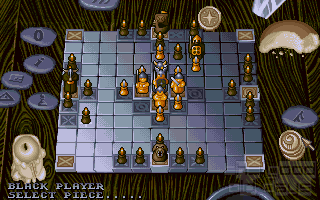Back in the early 80s, even on sinfully expensive arcade machines new game ideas appeared, which later disappeared without a trace. Due to the limited hardware, the coins were mainly lured by the skillful design of the gameplay. With Quack A Jack, a clone of such a Japanese arcade game was ported to the Amstrad CPC.
As a duck, you are on your way on a floor paneled with 11x20 tiles, along with some enemies, immobile cooking pots and an egg from which a deadly terraductile emerges after 10 seconds. If the egg is reached in time, another one will show up immediately somewhere on the playing field until the next level is reached. The enemies become more numerous and faster.
But there is a twist: you can't walk the same path twice. Floor tiles that have been walked on once disappear and the area gradually shrinks. The path to the next egg becomes increasingly complicated due to the missing floor tiles and resembles to some degree walking through a self-defined labyrinth.
However, two strategically useful approaches can be used: firstly, moving beyond the edge of the screen, which allows the player to reach the opposite side. In addition, an entire row can be moved to the right or left so that unused tiles can be reached again.
The game seems to have no algorithm for the egg-respawn that checks whether a path to the next egg even theoretically exists. Therefore, in later levels, the player not only needs a lot of speed and skill, but also luck to ensure that the egg does not land in an unreachable area. I doubt whether this was the case in the arcade version.
Nevertheless, the randomiser has also been used to advantage in other respects: the start screen is generated differently with each attempt, so that simple or rather difficult arrangements actually appear. In addition, although the enemies pursue the player on a macro level, they do not chase him specifically to the end. By stopping the movement or faking a change of direction, they can be specifically tricked on a micro level.

The winding paths and constant escape from enemies make the gameplay somewhat comparable to a very successful arcade game: the legendary Pac-Man. The developer of Quack A Jack was obviously aware of this, as a ghost sprite appears in the second level that looks confusingly similar to the Pac-Man ghosts. It's just a shame that the inspiration didn't go any further in this direction and that you can only pick up some nasty money for the highscore and not temporary immortality or extra lives.
Quack A Jack is one of those games that I would like to have known at that time. As apart from the Amstrad CPC, there is only one port for the Oric, it is fairly unknown. Even on that early stage of gaming, the competition was tough: Pac-Man became a legend, not the duck. In the series of these typical single-screen action games, it might even have become one of my favourites. Nowadays, as I'm no stranger to this type of game, I can clearly see the great potential that the Amsoft title had.


Comments (1) [Post comment]